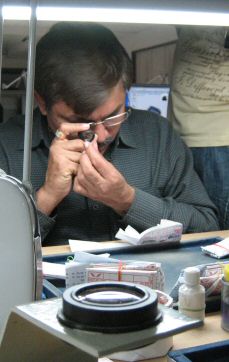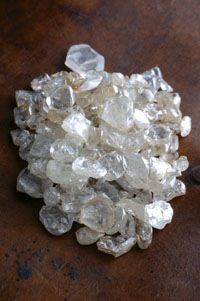IDEX Online February Rough Diamond Report: Calm Market Expected
March 04, 10
“The [February] Sight was crazy,” a market insider recently told IDEX Online. Testimony to that are the continued rising prices and the on again-off again surge in demand during the Sight week. After IDEX Online held a round of meetings in
The Diamond Trading Company (DTC) raised prices at the February Sight by an average of 7 to 7.5 percent, or by a “high single digit,” according to the DTC. However the price of many boxes were up by double digits, some rising by more than 15 percent.
In a recent discussion, GJEPC Chair Vasant Mehta told IDEX Online that India is the global hub of diamonds. He is, of course, right, partially because the financing is there. With India’s ability and willingness to buy the gems, naturally the sharpest price hikes were in the so-called ‘Indian goods’. For example, the Mixed Rejection box was up by about 16 percent, the price of the Grey Pique box rose by 19 percent and Preparers Low 2-10cts was jacked up by more than 20 percent - anywhere between 21 to 26 percent, depending on whom you ask.
The premiums paid on the goods shrank to about 6-7 percent on average, nearly in the same range of the price increase, leaving the price of the goods on the secondary market at the same price as in January or up by a couple percentage points. In other words, the DTC took a large chunk of the first hand premiums for itself.
 Examining a rough diamond ahead of polishing, at Venus Jewels in Surat, India’s diamond polishing center |
This may be true, but an important question still remains - why is the market willing to pay high prices for rough diamonds? After DTC prices dipped about 13-15 percent between December 2008 and December 2009, they rose by 15 percent in the first two months of 2010. With its good (yet expensive and stricter) financing, India buys up the goods because it can.
The appetite is there and the Indian center is ensuring that the goods are arriving in the sub-continent. Evidence to that is Alrosa’s recent statement that half of its open market sales were to Indian firms and that 40 percent of the DTC Sightholders are Indians. Add to that the 60 firm diamond consortium Diamond India Limited, which is seeking to buy goods directly from Africa in addition to Alrosa, and the ability to get the goods is clearly there.
The calculation many traders make today when buying the high priced goods is based on two components - lower inventory and speculation. India used to hold three to four-months worth of polished diamond supplies. Today that is down to about 45 days. Jewelry makers and retailers have a lower stock level too and are demanding the goods, making this a sellers market.
The speculation aspect goes beyond the belief that rough prices will continue to rise and won’t decline. The market is betting on polished prices moving up too. Several manufacturers expect that by the time the rough goods are ready to be sold, the prices of polished will justify the cost of rough.
Therefore, 1st Color Rejections (H-L) boxes, which DTC hiked by about 11 percent, still commanded a 10 percent premium. Commercial 2.5-4ct boxes, up ~9 percent, were sold at a 10 percent premium. Cubes 4-8gr, sold by the DTC for about $515-$525 per carat, still has a high 12 percent premium, some say even more.
|
|
The 2/3 Black Makeables 4-8gr boxes, up by 9.5 percent, were sold with an 8 percent premium, down from the 14 percent they used to command. The price of another “Indian” box, 1-3 Color Mixed Sawables +11/6gr, rose by about 12 percent, fetching a 12 percent premium, according to traders.
The DTC raised the prices of some high-end goods as well. The Fine 5-14.8ct box, is a +$4,600 per carat article after its price was hiked by ~12 percent. The
The DTC is not alone. Goods at BHP Billiton’s spot market jumped dramatically. One BHP Billiton buyer detailed how the price of an article he regularly bought from BHP nearly tripled since February 2009 and another doubled in price. Despite the price hikes, Sightholders are happy with the DTC, saying that its consistent supply and reasonable prices are worthwhile.
Indian manufacturers counting on polished prices to rise, especially by December-January, are expressing concern that if they are wrong, March 2011 may be a critical time for rough producers. They are implicitly conveying stern confidence in their own ability to weather a storm.
The DTC sold about $550 million worth of goods at the February Sight, marking the return of large Sights. Currently on Sightholders’ agenda is the new ITO - the breakdown of what, how much and when they want to get their supplies in the coming period. The ITO requests are due in a couple of weeks.
Rio Tinto Tender
Rio Tinto Diamonds plans to start holding tenders sometime this summer. The details are still a little sketchy, but it sounds like the miner plans to collect pricing as well as other market information through the tender. Select assortments of Rio Tinto’s Canadian goods will be offered in a closed tender for invited bidders. They will not necessarily be the company’s Select Diamantaires, but will include non-regular clients as well. The company, it seems, is interested in dipping its feet in the warm waters of high tendered prices as well as get to know potential clients a little better.
| Article | Demand | Remarks on Demand |
| Fine 2.5-4 ct & Fine 5-14.8 ct | Demand is high on 2.5-4 and medium for 5-14.8 | Similar demand compared to previous Sight |
| Crystals 2.5-4 ct & | Strong demand in 2.5-4 and medium demand for 5-14.8 | Higher demand compared to previous Sight (based on lack of goods in the market) |
| Commercial 2.5-4 ct & Commercial 5-14.8 ct | Strong demand for 2.5-4ct., Medium demand for 5-14.8ct | Similar demand compared to previous Sight |
| Spotted Sawables 4-8 gr | Strong demand | Better demand compared to last Sight |
| Chips 4-8 gr | Medium demand | lower demand compared to previous Sight |
| Colored Sawables 4-8 gr & Colored 2.5-14.8 ct | Strong demand for 4-8gr and strong demand for 2.5-14.8 | Similar demand compared to previous Sight |
| Makeables High 3grs +7 | Strong demand | Similar demand compared to previous Sight |
| Preparers Low 3-6 gr | Strong demand | Similar demand compared to last Sight |
| 1st Color Rejections (H-L) | Medium demand | Lower demand compared to previous Sight |
